*NURSING > EXAM > NURS 1102 PASSPOINT EXAM CARDIOVASCULAR Test Bank 2021 UPDATED 140 PAGES. All Questions with Correct (All)
NURS 1102 PASSPOINT EXAM CARDIOVASCULAR Test Bank 2021 UPDATED 140 PAGES. All Questions with Correct Solutions (GRADED A)
Document Content and Description Below
NURS 1102 PASSPOINT EXAM CARDIOVASCULAR Test Bank 2021 UPDATED 140 PAGES. All Questions with Correct Solutions (GRADED A) PREVIEW.... Question 1 See full question Which statement would lead the nu... rse to determine that a client lacks understanding of her acute cardiac illness and the ability to make changes in her lifestyle? You Selected: "I talked with my husband yesterday about working on a new budget together." Correct response: "I already have my airline ticket, so I will not miss my meeting tomorrow." Explanation: Question 2 See full question What is the expected outcome of thrombolytic drug therapy for stroke? You Selected: dissolved emboli Correct response: dissolved emboli Explanation: Remediation: Question 3 See full question The client with peripheral vascular disease has been prescribed diltiazem. The nurse should determine the effectiveness of this medication by assessing the client for: You Selected: vasodilation. Correct response: vasodilation. Explanation: Remediation: Question 4 See full question Alteplase recombinant, or tissue plasminogen activator (t-PA), a thrombolytic enzyme, is administered during the first 6 hours after onset of myocardial infarction (MI) to: You Selected: reduce coronary artery vasospasm.Correct response: revascularize the blocked coronary artery. Explanation: Remediation: Question 5 See full question A nurse is caring for a client with first-degree atrioventricular (AV) block. When instructing the spouse using a diagram, identify the area in the conduction cycle where this block occurs. You Selected: Your selection and the correct area, market by the green box. Explanation:Question 6 See full question A postoperative client is receiving heparin after developing thrombophlebitis. The nurse monitors the client carefully for bleeding and other adverse effects of heparin. If the client starts to exhibit signs of excessive bleeding, the nurse should expect to administer an antidote that is specific to heparin. Which agent fits this description? You Selected: Protamine sulfate Correct response: Protamine sulfate Explanation: Remediation: Question 7 See full question Following a percutaneous transluminal coronary angioplasty, a client is monitored in the postprocedure unit. The client's heparin infusion was stopped 2 hours earlier. There is no evidence of bleeding or hematoma at the insertion site, and the pressure device is removed. The nurse should plan to safely remove the femoral sheath when the partial thromboplastin time (PTT) is: You Selected: 75 seconds or less. Correct response: 50 seconds or less. Explanation: Question 8 See full question Prior to administering tissue plasminogen activator (t-PA), the nurse should assess the client for which contradiction to administering the drug? You Selected: history of heart failure Correct response: history of cerebral hemorrhage Explanation: Remediation: Question 9 See full questionThe nurse is concerned about the risks of hypoxemia and metabolic acidosis in a client who is in shock. What finding should the analyze for evidence of hypoxemia and metabolic acidosis in a client with shock? You Selected: Arterial blood gas (ABG) findings Correct response: Arterial blood gas (ABG) findings Explanation: Remediation: Question 10 See full question Which assessment findings would the nurse expect to find in the postoperative client experiencing fat embolism syndrome? You Selected: Column C Correct response: Column B Question 1 See full question A nurse is preparing to administer cardiac medications to two clients with the same last name. She checks the medication three times before entering the room to administer medications to the first client. While leaving the room, the nurse realizes she didn't check the client's identification before administering the medication. Which action should the nurse take first? You Selected: Document the medication error and completion of the variance report in the client's chart and notify the physician. Correct response: Return to the room, check the client's identification against the medication administration record, and complete a variance report if needed. Explanation: Remediation: Question 2 See full questionThe nurse is assessing a client with irreversible shock. The nurse should document which finding? You Selected: hypertension Correct response: circulatory collapse Explanation: Remediation: Question 3 See full question The nurse instructs a client with coronary artery disease in the proper use of nitroglycerin. The client has had 2 previous episodes of coronary artery disease. At the onset of chest pain, what should the client do? You Selected: Call 911 when three nitroglycerin tablets taken every 5 minutes are not effective. Correct response: Call 911 when three nitroglycerin tablets taken every 5 minutes are not effective. Explanation: Remediation: Question 4 See full question A client with chest pain doesn't respond to nitroglycerin. When he's admitted to the emergency department, the health care team obtains an electrocardiogram and administers I.V. morphine. The physician also considers administering alteplase. This thrombolytic agent must be administered how soon after onset of myocardial infarction (MI) symptoms? You Selected: Within 24 to 48 hours Correct response: Within 6 hours Explanation: Remediation: Question 5 See full questionA physician treating a client in the cardiac care unit for atrial arrhythmia orders metoprolol, 25 mg P.O. two times per day. Metoprolol inhibits the action of sympathomimetics at beta1 -receptor sites. Where are these sites mainly located? You Selected: Heart Correct response: Heart Explanation: Remediation: Question 6 See full question A client with left-sided heart failure complains of increasing shortness of breath and is agitated and coughing up pink-tinged, foamy sputum. The nurse should recognize these findings as signs and symptoms of: You Selected: right-sided heart failure. Correct response: acute pulmonary edema. Explanation: Remediation: Question 7 See full question An 80-year-old client is admitted with nausea and vomiting. The client has a history of heart failure and is being treated with digoxin. The client has been nauseated for a week and began vomiting 2 days ago. Laboratory values indicate hypokalemia. Because of these clinical findings, the nurse should assess the client carefully for: You Selected: digoxin toxicity. Correct response: digoxin toxicity. Explanation: Remediation: Question 8 See full questionThe nurse is assisting a client with a stroke who has homonymous hemianopia. The nurse should understand that the client will: You Selected: forget the names of foods. Correct response: eat food on only half of the plate. Explanation: Remediation: Question 9 See full question A client prescribed propranolol calls the clinic to report a weight gain of 3 lbs (1.36 kg) within 2 days, shortness of breath, and swollen ankles. What is the nurse’s best action? You Selected: Have the client come to the clinic in order to assess the lungs. Correct response: Have the client come to the clinic in order to assess the lungs. Explanation: Remediation: Question 10 See full question The nurse is preparing to administer oral digoxin to a child and notes that the child has nausea, has vomited, and has a pulse rate of 45 beats per minute. Which of the following is the appropriate nursing action? You Selected: Hold the digoxin and notify the physician of possible toxicity Correct response: Hold the digoxin and notify the physician of possible toxicity Question 1 See full question What is a priority nursing assessment in the first 24 hours after admission of the client with a thrombotic stroke? You Selected: echocardiogram Correct response: pupil size and pupillary response Explanation: Remediation: Question 2 See full question When monitoring a client who is receiving tissue plasminogen activator (t-PA), the nurse should have resuscitation equipment available because reperfusion of the cardiac tissue can result in: You Selected: hypertension. Correct response: cardiac arrhythmias. Explanation: Remediation: Question 3 See full question In a client with chronic bronchitis, which sign would lead the nurse to suspect right-sided heart failure? You Selected: Leg edema Correct response: Leg edema Explanation: Remediation: Question 4 See full question Which indicates hypovolemic shock in a client who has had a 15% blood loss? You Selected: systolic blood pressure less than 90 mm Hg Correct response: systolic blood pressure less than 90 mm Hg Explanation: Remediation: Question 5 See full questionWhich symptom should the nurse teach the client with unstable angina to report immediately to the health care provider (HCP)? You Selected: a change in the pattern of the chest pain Correct response: a change in the pattern of the chest pain Explanation: Remediation: Question 6 See full question The nurse is admitting an older adult to the hospital. The echocardiogram report revealed left ventricular enlargement. The nurse notes 2+ pitting edema in the ankles when getting the client into bed. Based on this finding, what should the nurse do first? You Selected: Assess respiratory status. Correct response: Assess respiratory status. Explanation: Remediation: Question 7 See full question The nurse teaches a client who has recently been diagnosed with hypertension about following a low- calorie, low-fat, low-sodium diet. Which menu selection would best meet the client's needs? You Selected: baked chicken, an apple, and a slice of white bread Correct response: baked chicken, an apple, and a slice of white bread Explanation: Remediation: Question 8 See full question A client has been diagnosed with Raynaud’s phenomenon on the tip of the nose and fingertips. The healthcare provider (HCP) has prescribed reserpine to determine if the client will obtain relief. The clientoften works outside in cold weather and also smokes two packs of cigarettes per day. Which directions should be included in the discharge plan for this client? Select all that apply. You Selected: Report signs of orthostatic hypotension. Stop smoking. Find employment that can be done in a warm environment. Correct response: Stop smoking. Wear a face covering and gloves in the winter. Report signs of orthostatic hypotension. Explanation: Remediation: Question 9 See full question A client hospitalized with a myocardial infarction (MI) has a blood glucose levels ranging from 12-28 mmol/L (216-504 mg/dL) asks the nurse why the readings are so high even though there are no added sweets on the diet tray. What is the best response by the nurse? You Selected: “The stress level in your body has increased with the MI, and more glucose is released during stressful times.” Correct response: “The stress level in your body has increased with the MI, and more glucose is released during stressful times.” Explanation: Remediation: Question 10 See full question A client with chest pain, dyspnea, and an irregular heartbeat comes to the emergency department. An electrocardiogram shows a heart rate of 110 beats/minute (sinus tachycardia) with frequent premature ventricular contractions. Shortly after admission, the client has ventricular tachycardia and becomes unresponsive. After successful resuscitation, the client is taken to the intensive care unit (ICU). Which nursing diagnosis is the priority at this time? You Selected: Ineffective tissue perfusion (cardiopulmonary) related to arrhythmiaCorrect response: Ineffective tissue perfusion (cardiopulmonary) related to arrhythmia Question 1 See full question A client signed a consent form for participation in a clinical trial for implantable cardioverter- defibrillators. Which statement by the client indicates the need for further teaching before true informed consent can be obtained? You Selected: "I wonder if there is any other way to prevent these bad rhythms." Correct response: "I wonder if there is any other way to prevent these bad rhythms." Explanation: Remediation: Question 2 See full question The client asks the nurse, “Why will the health care provider not tell me exactly how much of my leg he is going to take off? Do you not think I should know that?” On which information should the nurse base the response? You Selected: the adequacy of the blood supply to the tissues Correct response: the adequacy of the blood supply to the tissues Explanation: Remediation: Question 3 See full question When assessing a client with left-sided heart failure, the nurse expects to note: You Selected: pitting edema of the legs. Correct response: air hunger. Explanation: Remediation:Question 4 See full question A nurse is providing discharge instructions to a client with peripheral vascular disease that include stress- reduction techniques. The client asks the nurse, "Why is reducing stress so important?" What is the nurse's best response? You Selected: "Stress reduction techniques are helpful because stress stimulates the release of vasoconstricting catecholamines." Correct response: "Stress reduction techniques are helpful because stress stimulates the release of vasoconstricting catecholamines." Explanation: Question 5 See full question A client who underwent total hip replacement exhibits a red, painful area on the calf of the affected leg. What test validates presence of thromboembolism? You Selected: Homans' Correct response: Homans' Explanation: Remediation: Question 6 See full question A client, hospitalized with heart failure, is receiving digoxin and furosemide intravenously and now has continuous ringing in the ears. What is the appropriate action for the nurse to take at this time? You Selected: Obtain a digoxin level to check for toxicity. Correct response: Discontinue the furosemide and notify the health care provider (HCP). Explanation: Remediation: Question 7 See full questionAn older adult with a history of heart failure is admitted to the emergency department with pulmonary edema. On admission, what should the nurse assess first? You Selected: serum potassium level Correct response: blood pressure Explanation: Remediation: Question 8 See full question One goal in caring for a client with arterial occlusive disease is to promote vasodilation in the affected extremity. To achieve this goal, the nurse should encourage the client to: You Selected: stop smoking. Correct response: stop smoking. Explanation: Remediation: Question 9 See full question When performing external chest compressions on an adult during cardiopulmonary resuscitation (CPR), the rescuer should depress the sternum: You Selected: 1.5 inches (4 cm) Correct response: 2 inches (5 cm) Explanation: Remediation: Question 10 See full question A nurse places electrodes on a collapsed individual who was visiting a hospitalized family member, the monitor exhibits the following. Which interventions would the nurse do first? You Selected: [Show More]
Last updated: 1 year ago
Preview 1 out of 140 pages
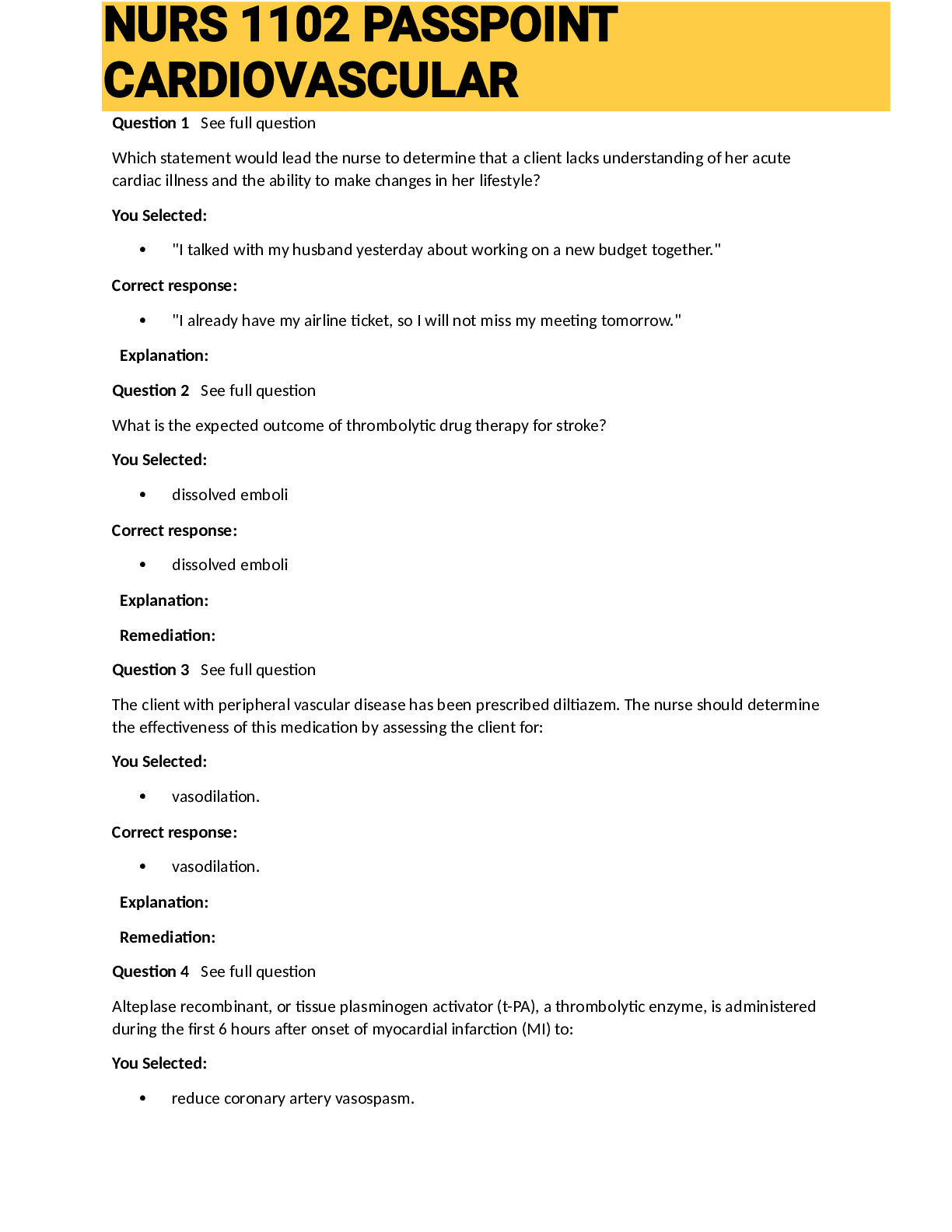
Reviews( 0 )
Document information
Connected school, study & course
About the document
Uploaded On
Oct 13, 2021
Number of pages
140
Written in
Additional information
This document has been written for:
Uploaded
Oct 13, 2021
Downloads
1
Views
244





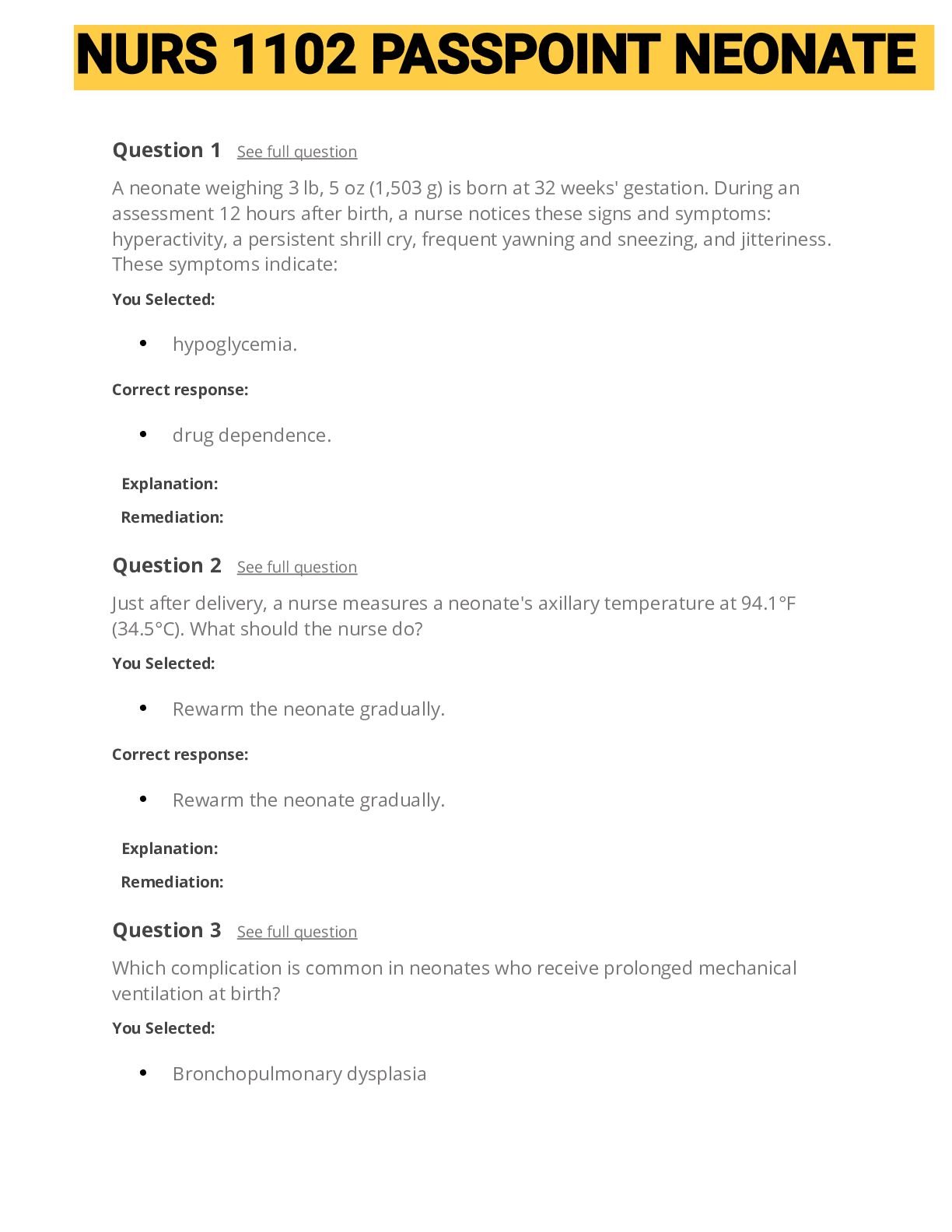

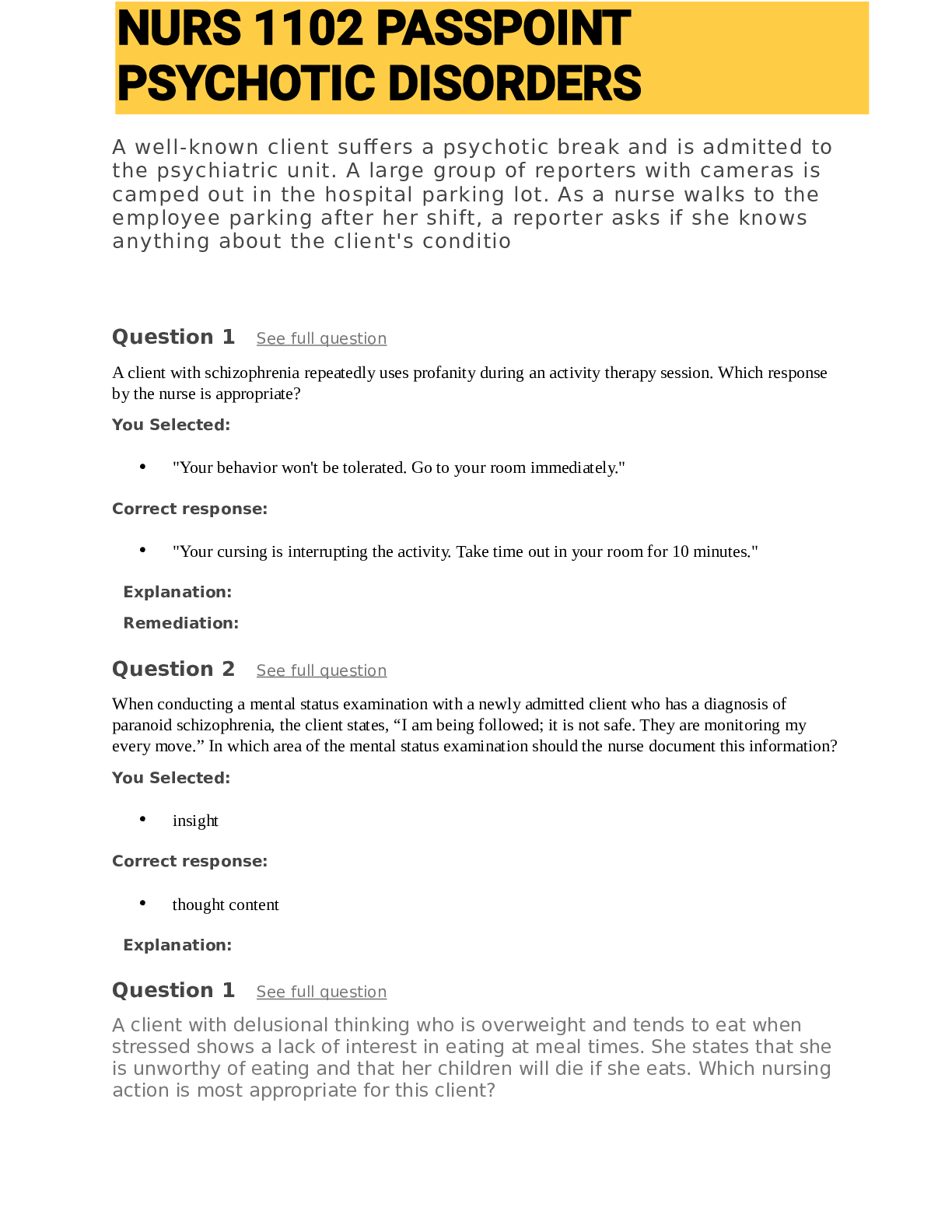

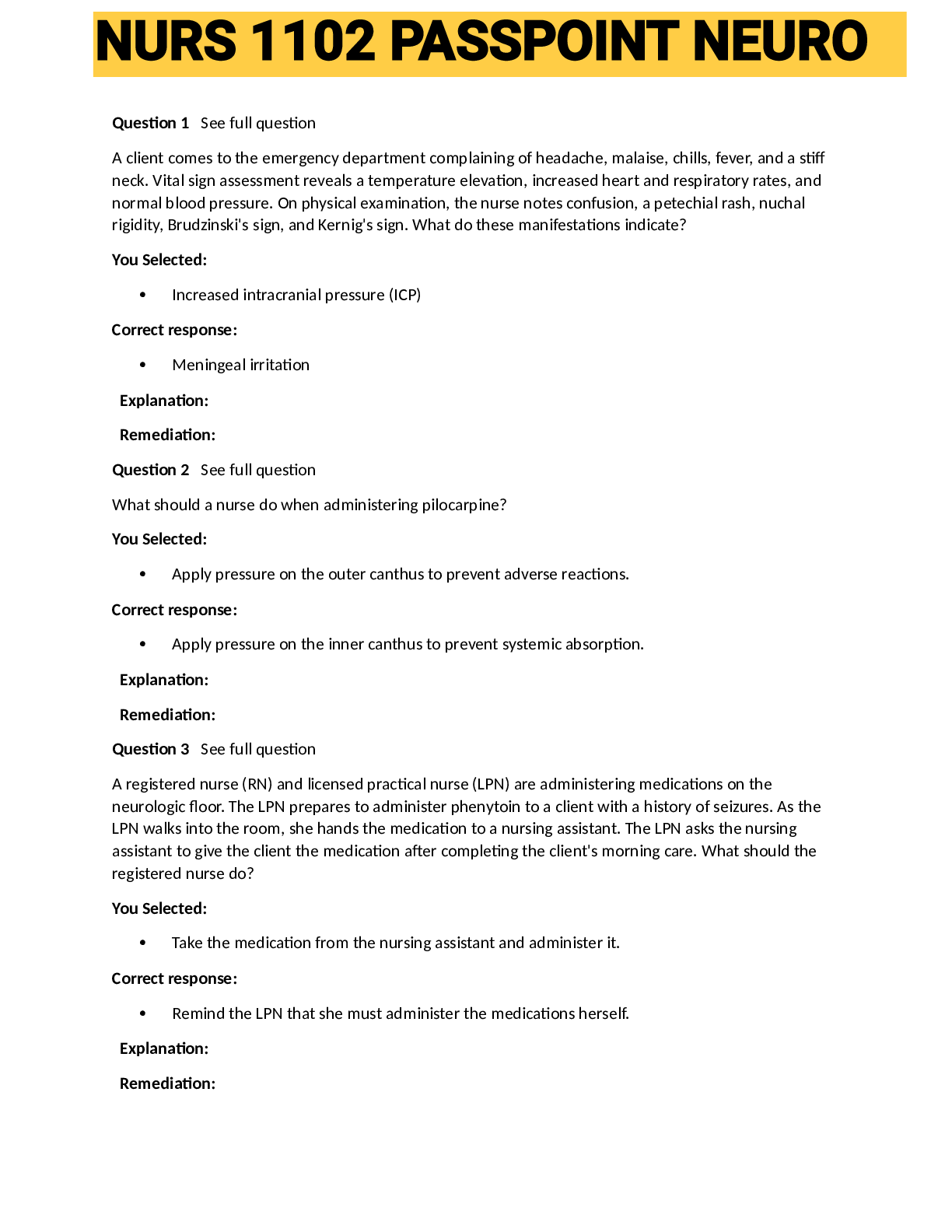



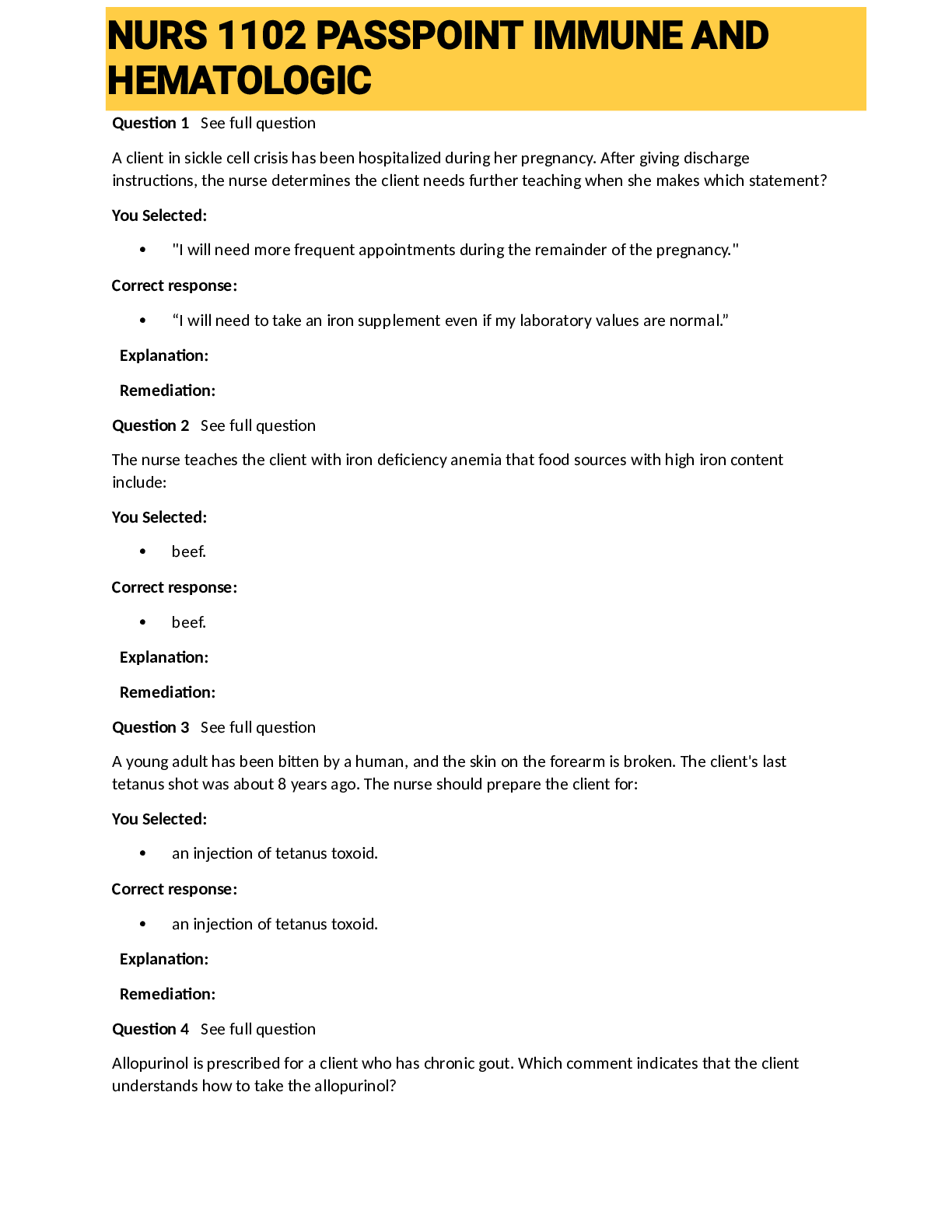
.png)
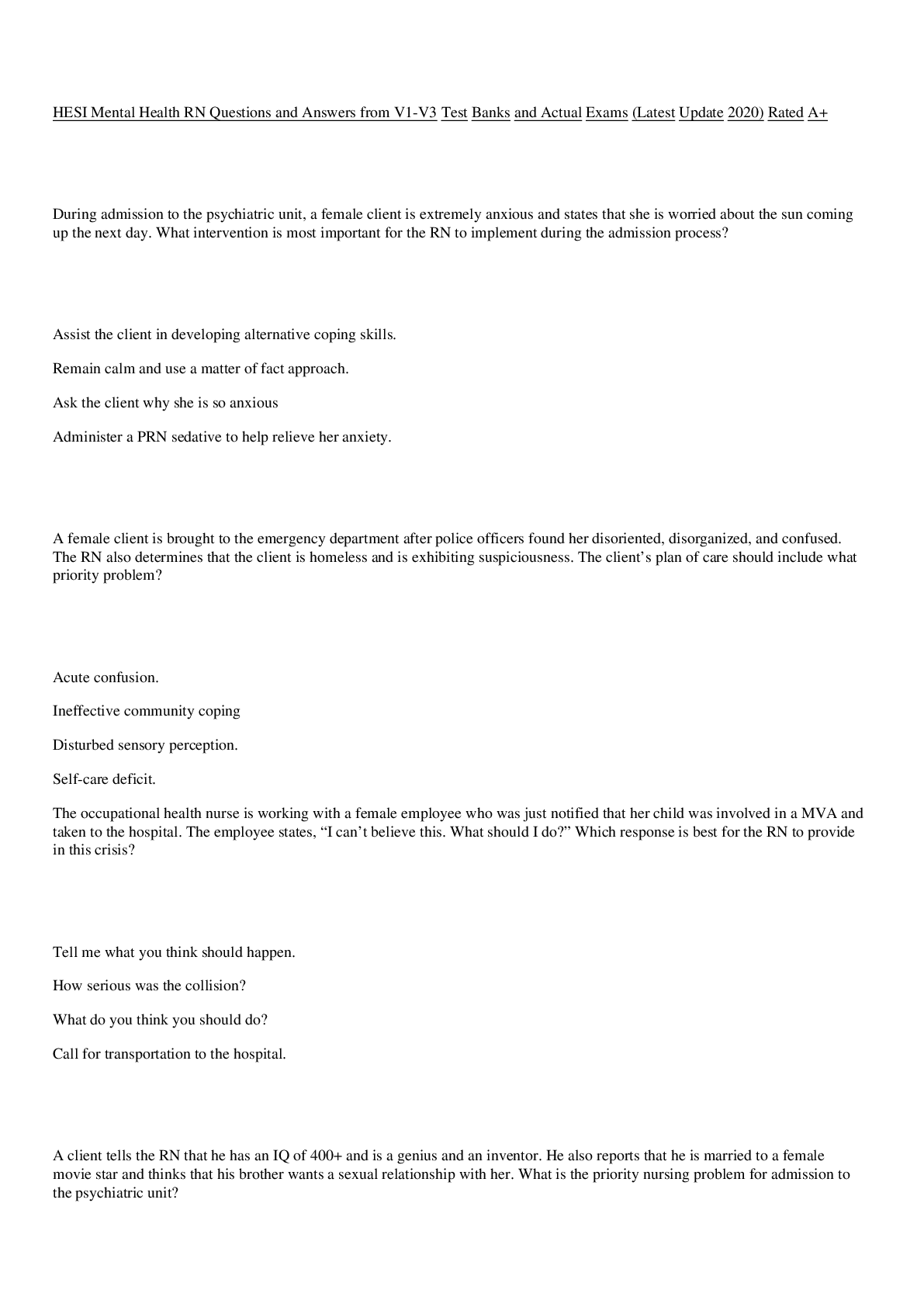
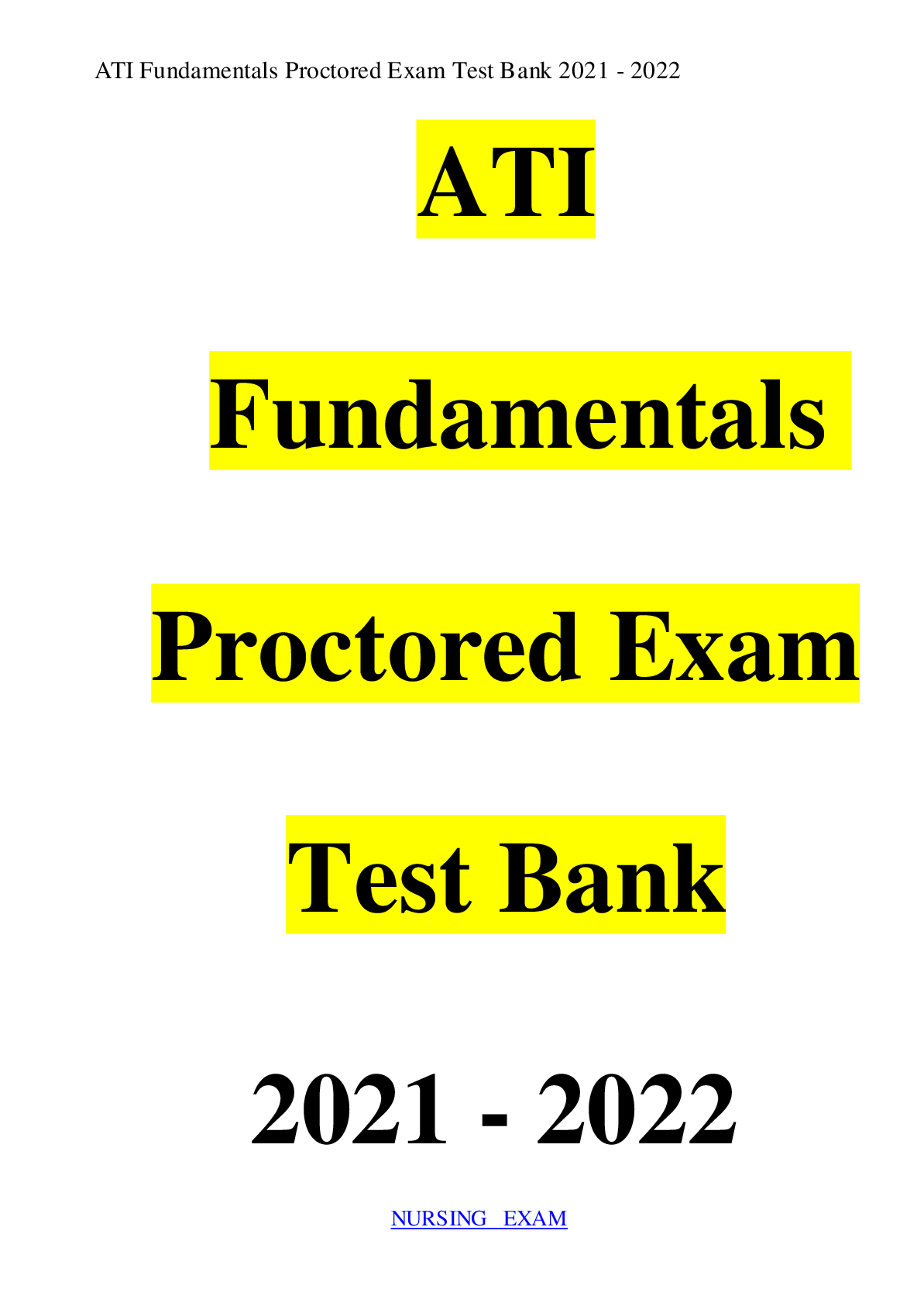


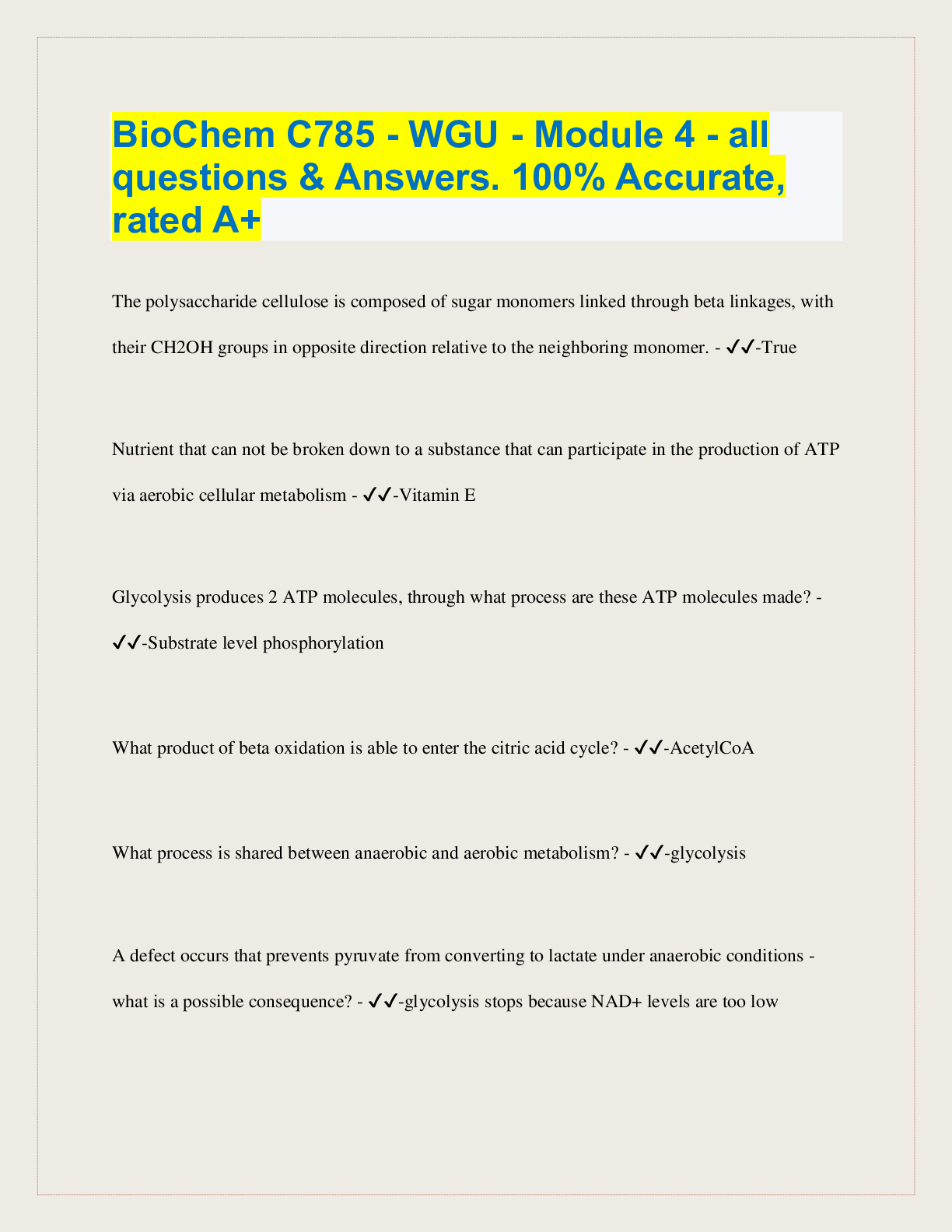
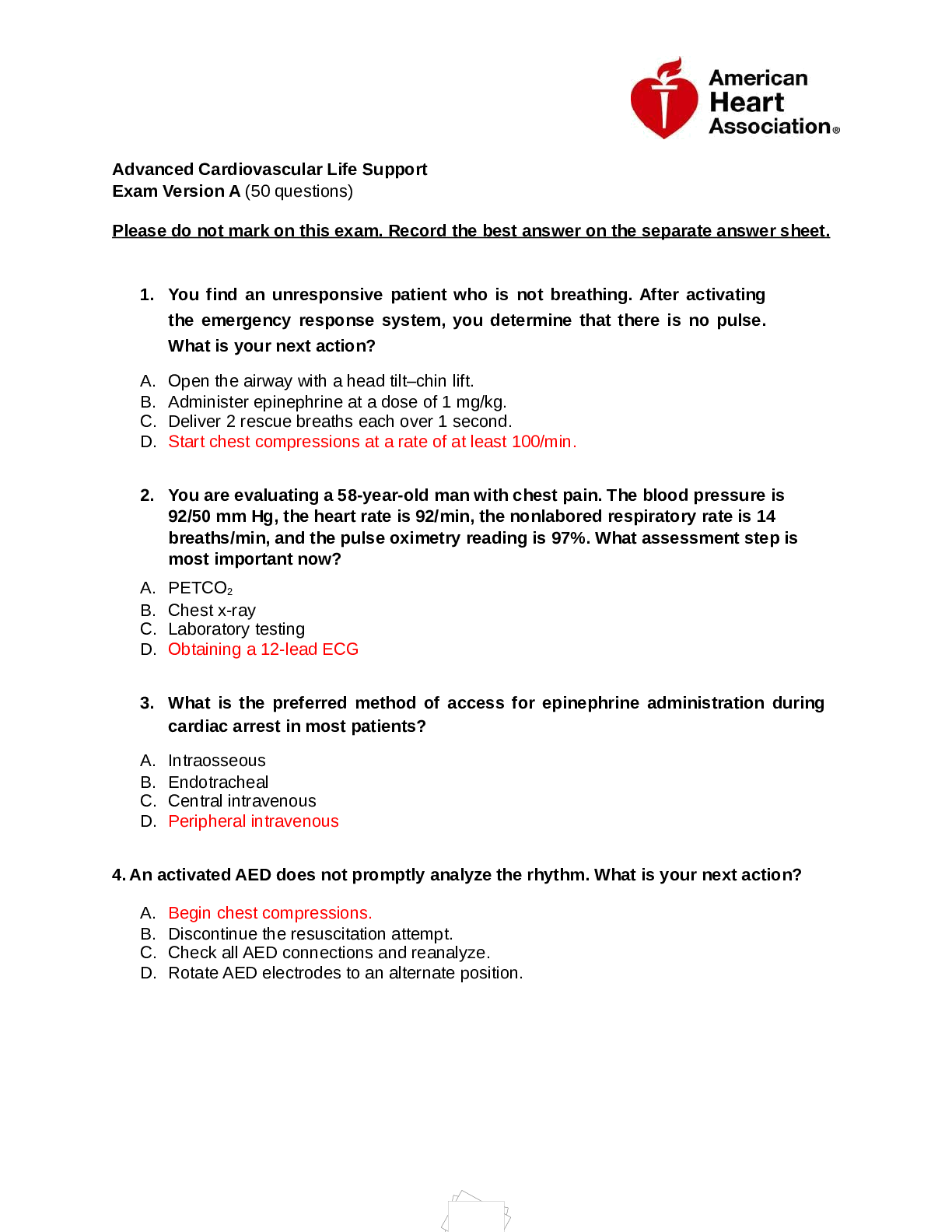
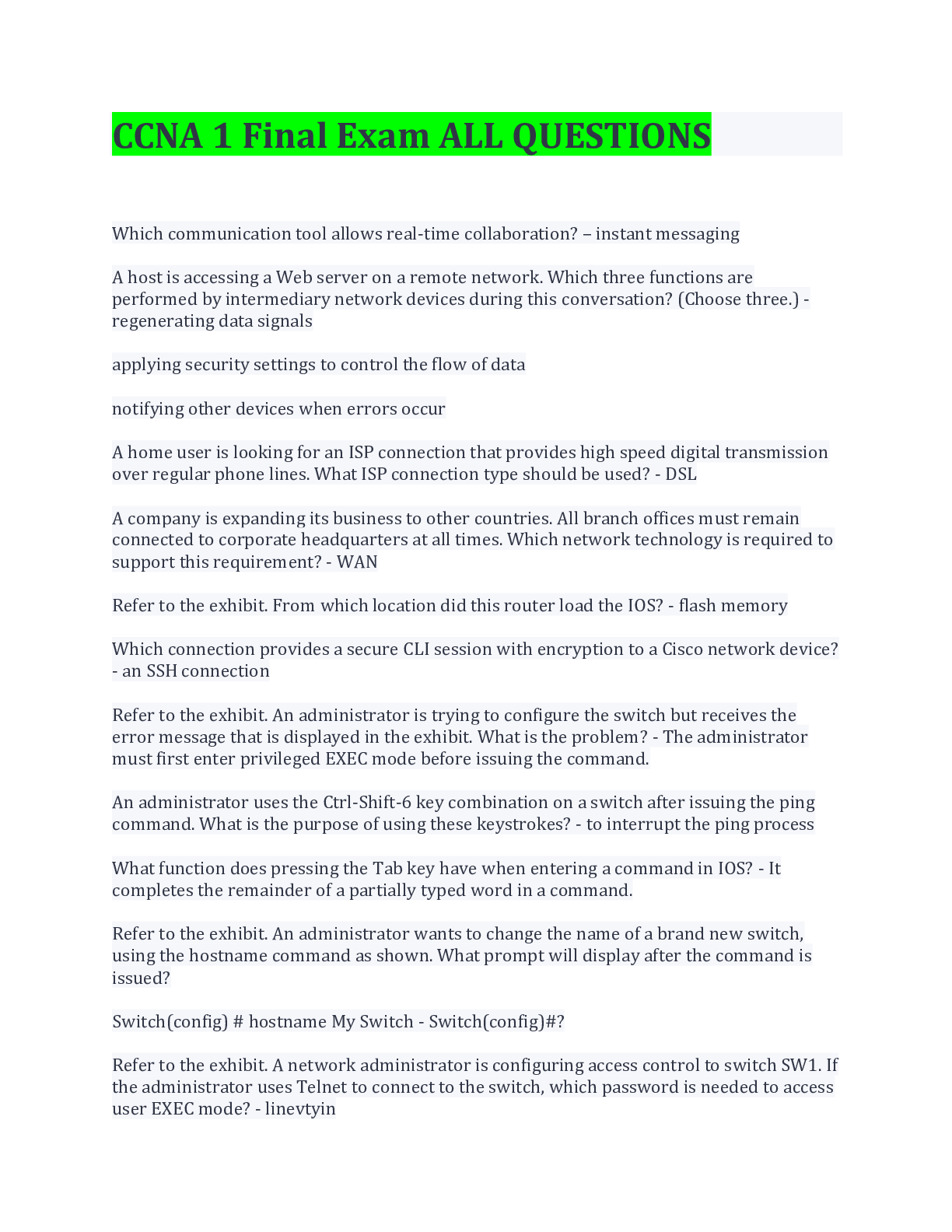

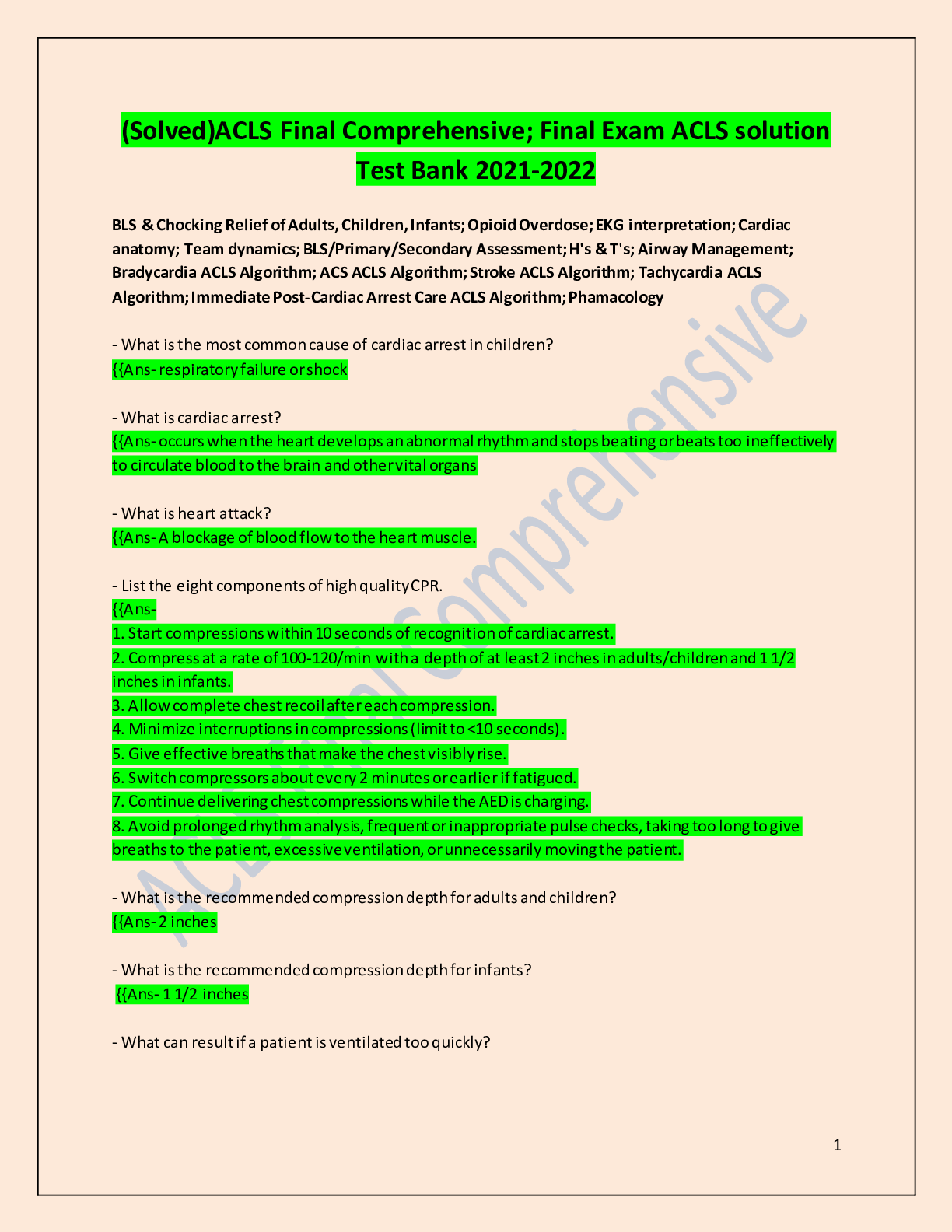


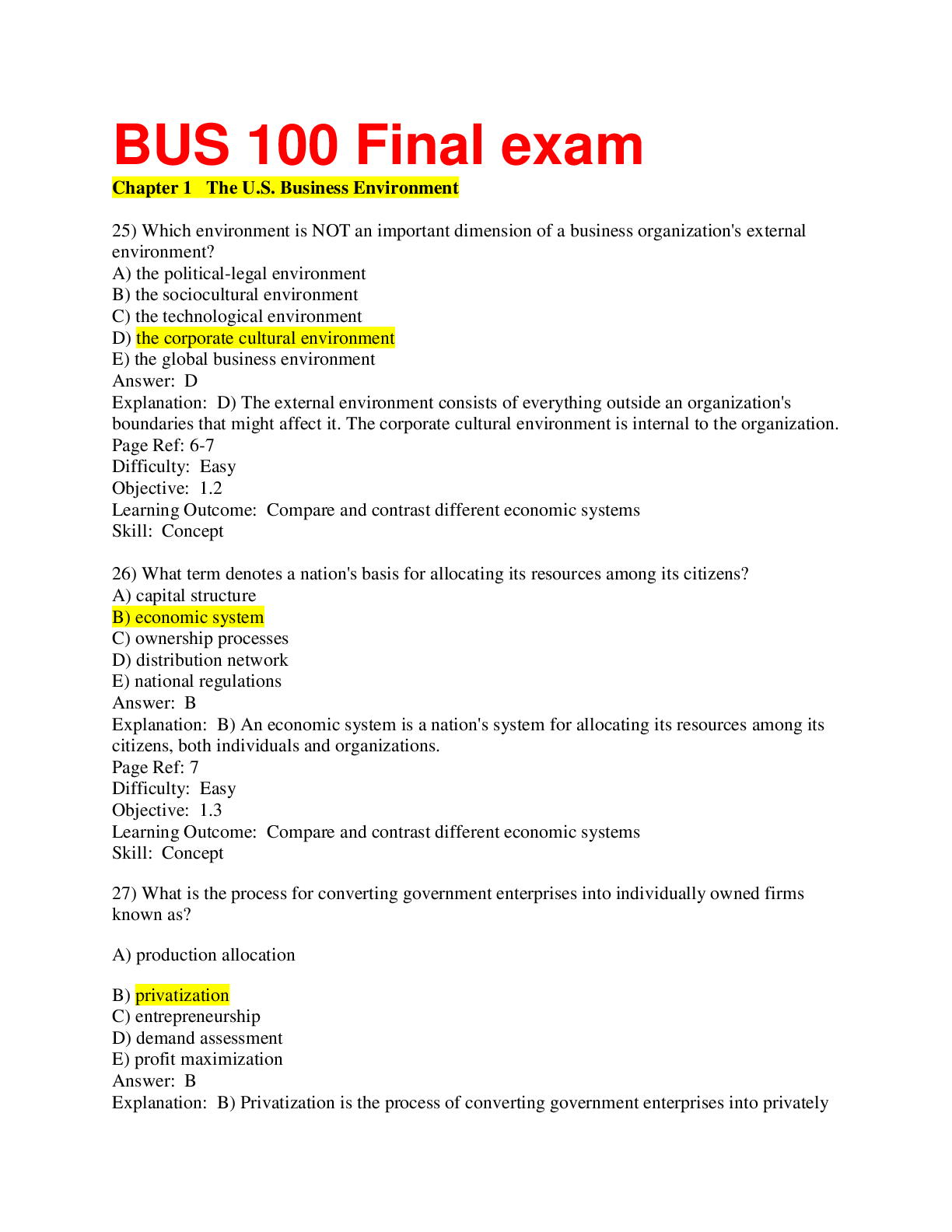

.png)

